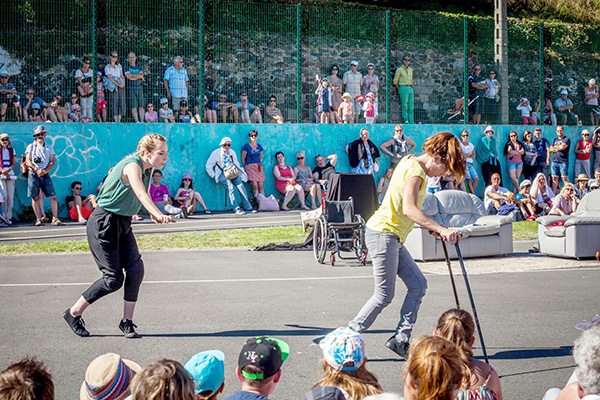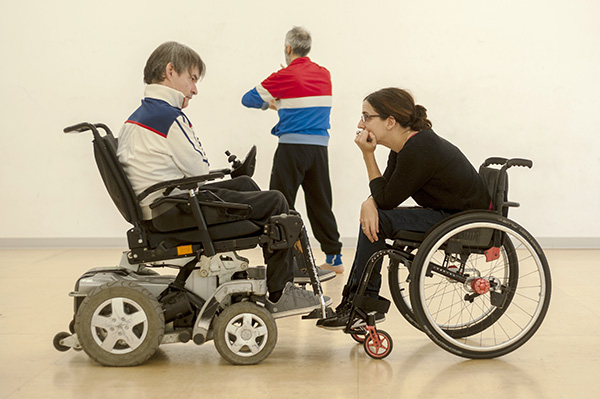Maylis Arrabit’s Story
Maylis Arrabit is a French performer and choreographer who dances (mostly) from her wheelchair. She shares her personal journey finding dance, her decision to pursue it professionally, and her hopes for spreading integrative dance throughout France and beyond.
Laura Mazeaud and Maylis Arrabit, Photo by Manuel Guyon
~~
My name is Maylis. I am 30 years old. I live in Basque country, which is located in the southwest of France and is a shared territory with Spain. I decided to dance one year ago. I’ve been dancing and training for six years, but I decided to focus on dance and only dance one year ago. In the instant I made that decision, a burden on my shoulders lifted and I thought, “Okay, this is it.”
My first dance class was with AXIS Dance Company in Oakland, CA back in 2011. I heard about AXIS via a video on YouTube. There before me were people dancing in wheelchairs. I thought, “Wow, that’s interesting!” So I Facebooked them and watched all of their videos. One year later, I was in the midst of my master’s degree in psychology and having a really hard time. I spent two to three months mostly in bed not knowing what I wanted to do. One day, I was on the internet, and AXIS posted something like: “If you want to apply for our summer program, do it now!” I thought maybe that would be the best thing for me. It would be an opportunity to get perspective on problems in my life. I went, and it was amazing.
It was a revelation; I discovered my passion for dance. I’m still in touch with many people from that first intensive with AXIS. After that, I knew I wanted to keep dancing. At AXIS, I had been in a wonderful inclusive dance bubble where everyone was welcome and appreciated. Going back to France, I didn’t know if I could find a teacher who could help me. My only goal was to keep dancing. Upon returning to France, I went back to the university to continue my studies, and the first thing I did was seek out a dance class.
I found a contemporary dance class where the teacher was really supportive and okay with me being in a wheelchair. I kept going. I finished my degree and went back to my hometown. I found another teacher, and another one, and another one, and another one. This is how I kept dancing for the past six years, training in contemporary dance with as many teachers as I could.
The folks at AXIS told me there were different integrated dance companies in the UK that I could train with. I did several workshops, and learned that Stopgap was more for me than other programs. Stopgap started to feel like my second home, how inclusive and friendly they are. I go train with them every chance I can.
I went to a workshop in Belgium with Adam Benjamin in 2016. After I got home, I realized, “This is it. I don’t want to keep thinking about other jobs. I want to dance. This is my time, and I might not get the time again.” But I really had nothing. All I had was an idea in my head.
I decided to try to make my own piece. I started working in the studio, in Spain, with two dancers, choreographing my first piece. One month in, I got a call from Tomos Young saying he wanted to start an inclusive dance company in Normandie (France), and wondered if I was available to dance in it. I immediately responded, “Yes I am!” Everything just came together. It felt like making the decision to dance made the opportunity.
It’s a very new project-based company called InterDanse. Tomos Young, the artistic director, was a dancer with Stopgap for four years, and we met back in 2014 during an EU-funded project called Integrance. His mother is based in France, and he came back to where he was raised and realized there was no inclusive dance.
It’s all still very new. We still need to grow and get funding. It feels like we’re pioneers paving the way. We’re a new generation making inclusive dance.
But I’m used to being in that position. I was the first disabled person in my high school, and the first disabled person to graduate with a psychology degree from my university. Maybe I’m just in the right generation and lucky that way.
To that end, I feel like I’m trying to find my own thing. Who am I as a dancer? What is my uniqueness? What I’m also looking for is a sense of belonging, of being a part of something. I’ve started to realize that, with InterDanse, I belong to the group. Without me, it would be different. So I am both unique within it and I still belong. I also ask myself: What can I bring to others and to the field?
The piece I am currently making, Habrá Que Ponerse Cachas, is a duet about brotherhood. I ask: What does it mean to be part of the same family? How does a familial relationship change between when you are young and when you are an adult? I’m working with two male dancers in their 40s. One is disabled and the other is non-disabled. They both have brothers and sisters, and we have many discussions about that as we build the work. I try to build on their individual virtuosities.
Rehearsal of Habrá Que Ponerse Cachas, Photo by Gari Garaialde
As a choreographer, I consider virtuosity to be the little details that show what one person does best, that nobody else does quite the same. For example, one of the dancers I’ve been creating my piece with has spasticity. When I ask for stillness, he does it with a little spasm of his shoulder or finger which, for me, is his virtuosity. I love the way he moves and makes my choreography his own. Virtuosity is not about how high or how fast, but about something ineffably particular to each person.
France doesn’t have much inclusive dance, so my dream is to share what we’re doing with a larger audience, to tour to different festivals, and to keep finding inspiration to do what we’re doing. My hope is that life will keep inspiring me to keep going.
~~
Maylis Arrabit took her first dance class in 2011 with AXIS in Oakland, California. It’s there that everything changed! In 2012, after finishing her Masters in organizational psychology and returning to her native France, she joined Co&ciedanse (Biarritz) as a student and dancer, a contemporary dance company for amateurs led by Deva Macazaga. Following the departure of Deva from Biarritz, Maylis took contemporary dance classes with Wyllia Lapouge and various teachers in France and Spain. She enriched her knowledge of inclusive practice by taking workshops with Adam Benjamin, Candoco dance company, Jordi Cortes and Stopgap. She participated in Integrance (2014-2015) – an EU funded project which brought together four companies from Belgium, Scotland, France and England to promote the practice of inclusive dance – as well as danced in Gorputza, a dance piece choreographed by Jordi Cortés as part of the festival dFeria in San Sebastian (Spain). At the end of 2016, Maylis chose to focus on dance and is currently working on her first project, Habrá Que Ponerse Cachas, a duet for two male dancers with and without disabilities. In 2017, she joined InterDanse, a new dance company under the artistic leadership of Tomos Young (Normandie, France). InterDanse’s first creation, #Onesttoutslashrien, premiered in July 2017 as part of Les Sorties de bain festival in Granville, France. Maylis hopes it’s just the beginning.


